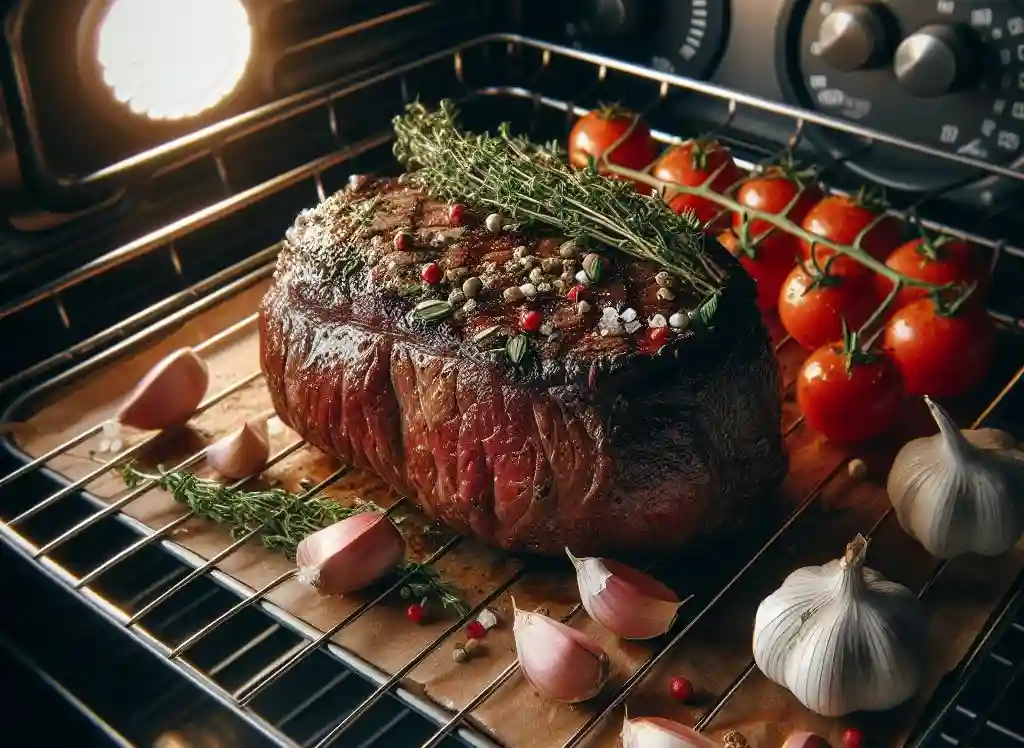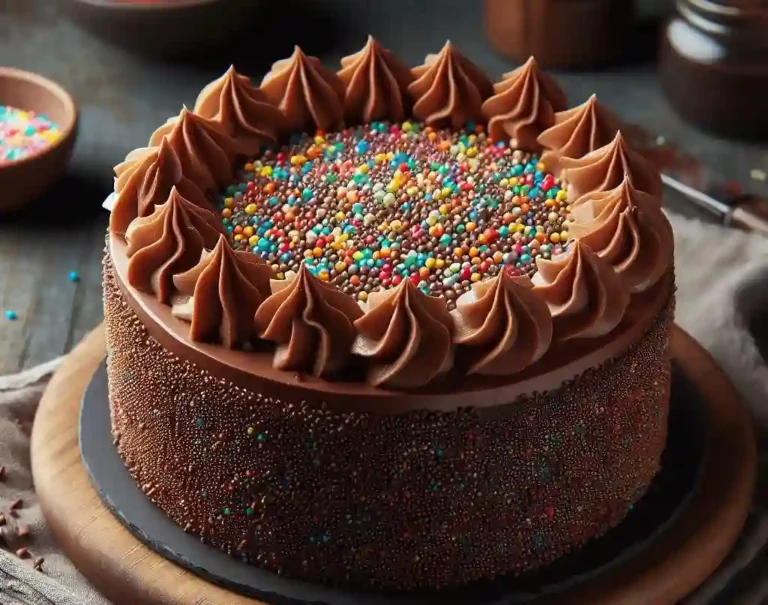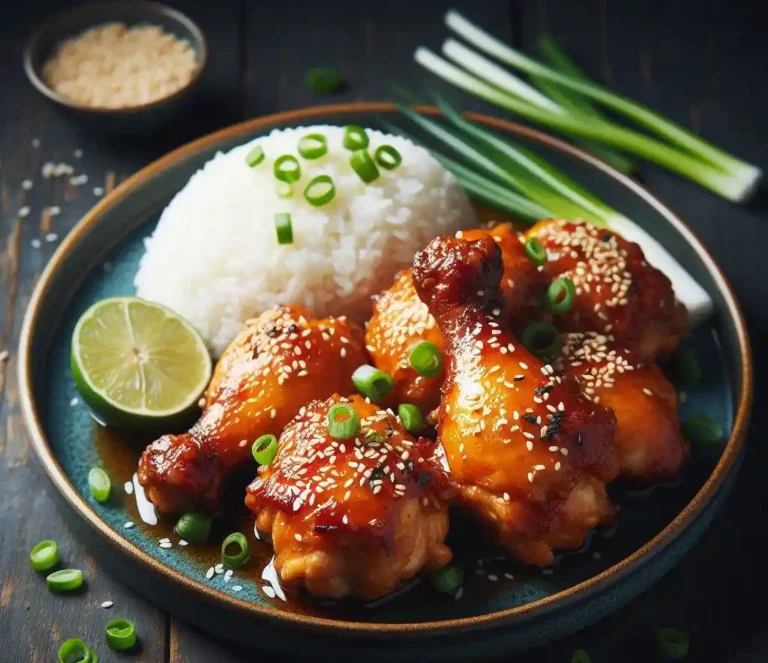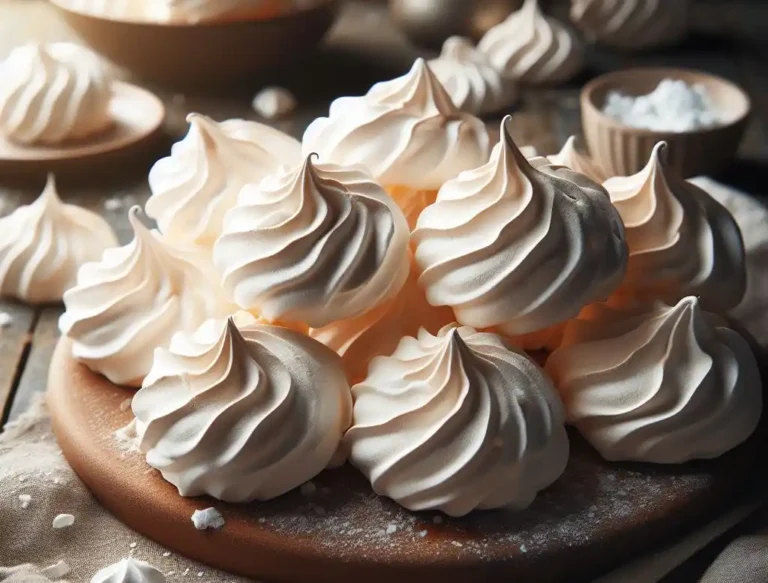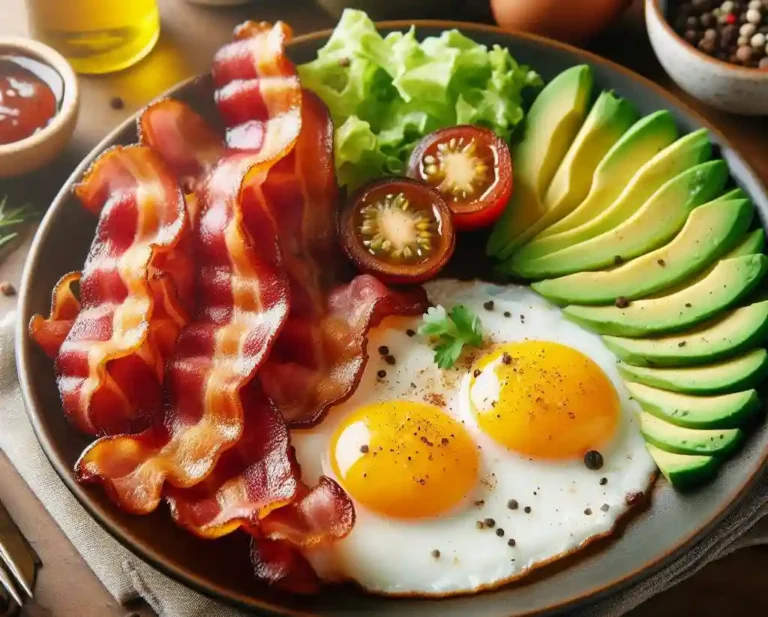How to Cook Steak in the Oven Without Searing: Delicious Results Without Searing
Steak in the Oven Without Searing: Are you tired of the hassle and mess of searing steaks on the stovetop? Or maybe you don’t have access to a grill but still want to enjoy a perfectly cooked steak?
Look no further, because we have the solution for you: cooking steak in the oven without searing. With this method, you can achieve deliciously tender and flavorful steaks without the added step of searing. Plus, you’ll save time and avoid any potential kitchen mishaps.
Keep reading to learn how to cook steak in the oven without searing and get ready to impress your taste buds.
How to Cook Steak in the Oven Without Searing: A Quick Overview
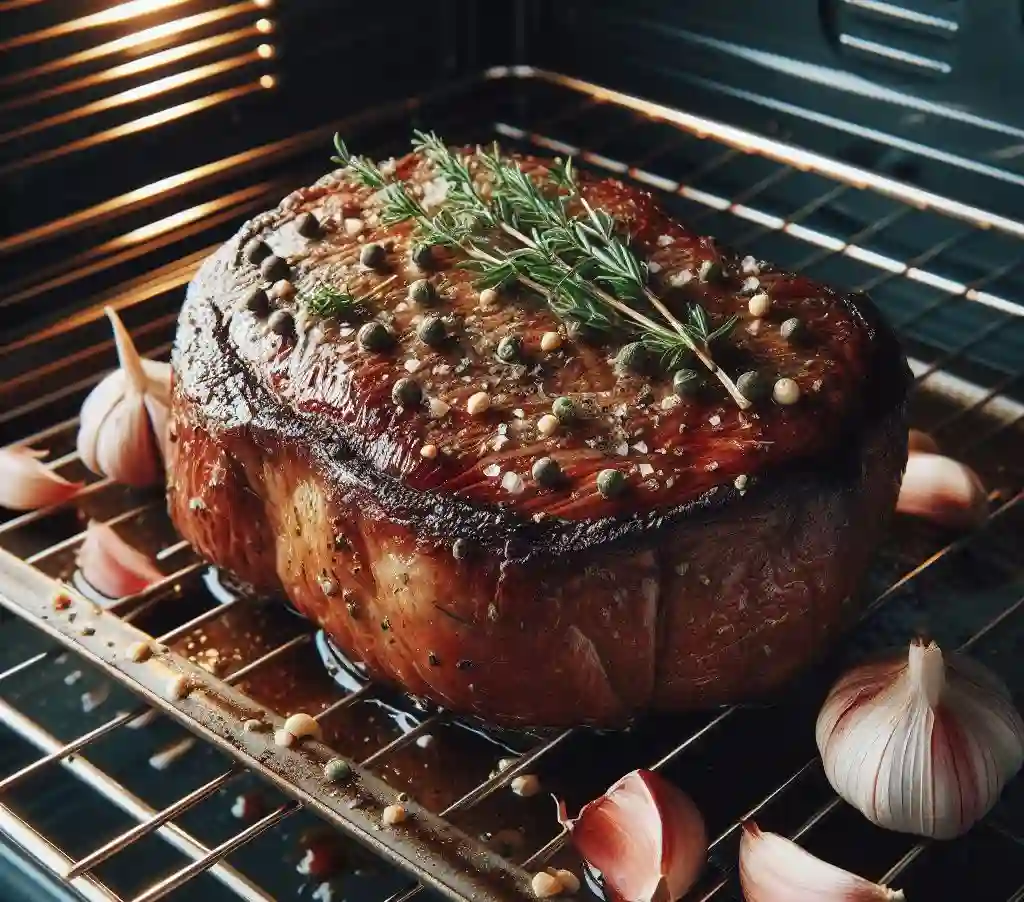
- Preheat your oven to a temperature range between 275°F to 325°F. This lower heat mimics slow cooking, allowing your steak to cook through evenly without the exterior becoming too hard or overdone.
- Select the right cut of steak, aiming for thicker cuts such as ribeye, New York strip, or filet mignon. These cuts have the ideal thickness and fat content for oven baking without searing.
- Allow your steak to reach room temperature before cooking, approximately 30 minutes. This step ensures more even cooking throughout the steak.
- Dry your steak thoroughly with paper towels to remove excess moisture. This helps in achieving a better texture and flavor as it cooks.
- Season your steak generously on both sides with kosher salt and freshly ground black pepper. For added flavor, you can include garlic powder, smoked paprika, or dried thyme to your seasoning mix.
- Place the seasoned steak on a wire rack set over a baking sheet to allow air circulation around the steak, promoting even cooking. Alternatively, you can use a preheated, lightly oiled cast iron skillet.
- Insert a meat thermometer into the thickest part of the steak without touching any bone. This tool is essential for monitoring the steak’s internal temperature to achieve your desired level of doneness.
- Cook the steak in the preheated oven following the suggested temperature and time guidelines, adjusting based on the thickness of your steak and your preferred level of doneness.
- After cooking, let the steak rest for 5 to 10 minutes before serving. This resting period allows the juices to redistribute throughout the meat, ensuring a juicy and flavorful steak.
- Serve with your choice of sides and sauces to complement the rich flavors of the oven-baked steak.
Understanding the Basics of Oven-Baked Steak
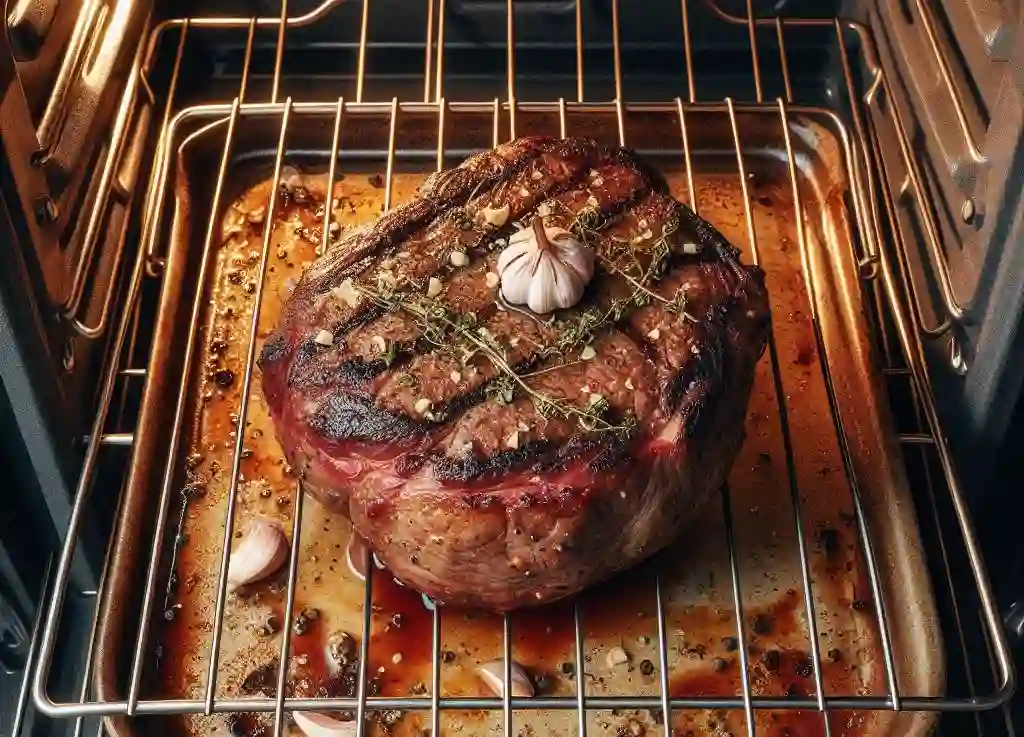
To master the technique of cooking steak in the oven without searing, it’s essential to grasp a few fundamental concepts. First, recognize that the oven provides a consistent, all-around heat source, different from the direct heat used in searing.
This difference affects how the steak cooks internally, often resulting in a more evenly cooked piece of meat.
The key is slow-roasting at a lower temperature, which allows the steak to cook through without the exterior burning or becoming too crusty before the interior reaches the desired level of doneness.
It’s also critical to understand that without the initial sear, the steak won’t have the traditional grilled or pan-seared crust, but it can still develop a desirable texture and rich flavor through proper seasoning and the use of a wire rack to enhance air circulation.
Additionally, moisture control is vital; ensuring the steak is dry before it goes into the oven helps to achieve a better result. By acknowledging these basics, you’ll set a strong foundation for creating a succulent, oven-baked steak that satisfies your culinary desires without needing to sear beforehand.
Choosing the Right Cut for Oven Baking
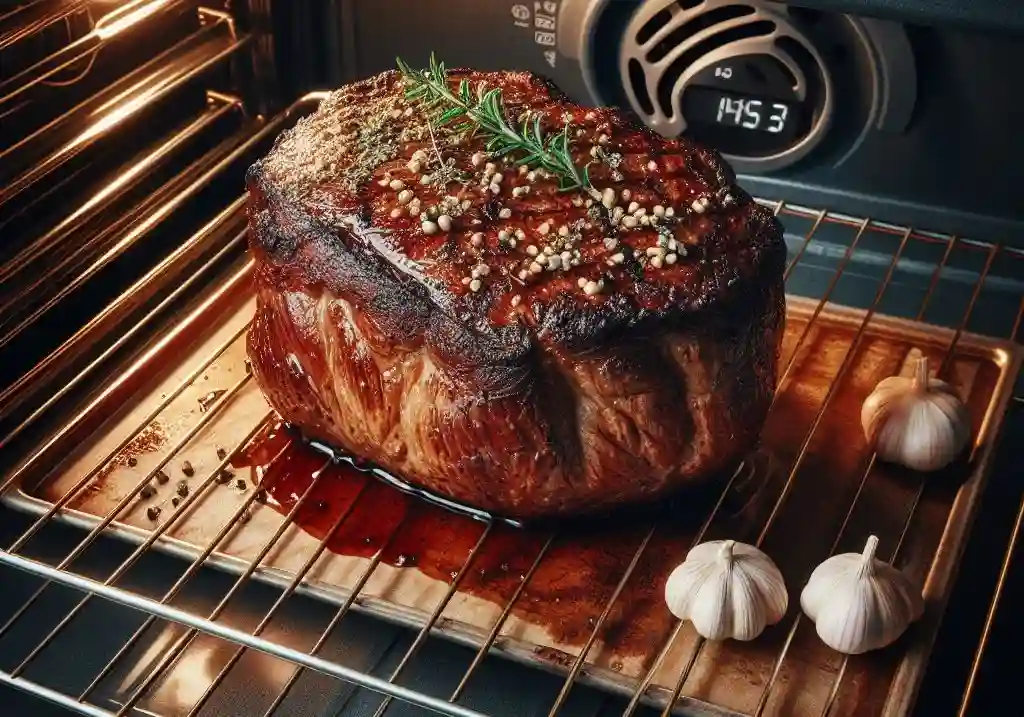
When it comes to cooking steak in the oven without searing, selecting the right cut is crucial for achieving the best results. Thicker cuts of steak are more forgiving and better suited for the oven’s gentle, even heat.
Consider cuts like ribeye, New York strip, or filet mignon for their optimal thickness and fat content, which contribute to a juicy, flavorful finish. These cuts have enough internal fat (marbling) to keep them moist during the slow-cooking process, enhancing their flavor and tenderness.
Avoid leaner cuts, such as flank or skirt steak, as they can become tough when not seared and cooked quickly. If you prefer these leaner cuts, marinating them beforehand can help tenderize the meat, but keep in mind that the end result may still not be as tender as the thicker, fattier options.
Choosing a steak that’s at least 1 to 1.5 inches thick will ensure that your steak cooks evenly throughout, without the outside becoming overdone before the inside reaches the desired level of doneness.
Seasoning Your Steak to Perfection
Seasoning your steak properly is a key component in enhancing its flavor and achieving a delectable outcome, especially when cooking in the oven without searing. Start by taking your steak out of the refrigerator and letting it come to room temperature for about 30 minutes.
This step ensures more even cooking. Lightly pat the steak dry with paper towels to remove excess moisture, as this will help the seasoning stick better. Generously season both sides of the steak with kosher salt and freshly ground black pepper.
The coarseness of kosher salt and fresh pepper provides a robust flavor that penetrates the meat. For an added burst of flavor, consider incorporating garlic powder, smoked paprika, or dried thyme into your seasoning mix.
If you’re feeling adventurous, a light brushing of olive oil before adding your dry seasonings can help the flavors adhere to the steak and contribute to a slight crust. Remember, the key is to season liberally, as some of the seasoning will inevitably be lost during the cooking process.
Properly seasoned, your steak will be ready to deliver a taste sensation after its oven journey, even without the traditional sear.
Preparing Your Steak for the Oven
To prepare your steak for the oven, begin by placing it on a wire rack over a baking sheet. This setup allows air to circulate around the steak, ensuring it cooks evenly on all sides and mimicking the effect of searing by creating a slightly crusty exterior.
If you don’t have a wire rack, you can place the steak directly on a preheated, lightly oiled cast iron skillet inside the oven, which also aids in even cooking. Before placing your steak in the oven, ensure it is at room temperature to promote uniform cooking.
It’s also critical to pat the steak dry once more before it goes into the oven, even after the initial drying for seasoning. Moisture on the surface of the steak can steam rather than roast the meat, impacting the texture and flavor negatively.
After positioning your steak on the rack or skillet, insert a meat thermometer into the thickest part of the steak without touching any bone. This will be your best tool for monitoring its doneness as it cooks. With your steak prepared and the oven preheated to the right temperature, you’re now ready to cook it to perfection without searing.
Seasoning Your Steak Perfectly
For a perfectly seasoned steak, the secret lies in understanding the balance and variety of seasonings that can elevate the flavor beyond the basic salt and pepper. While these two are foundational, introducing herbs and spices like rosemary, thyme, or a touch of cayenne can add depth and complexity.
Mixing a small amount of olive oil with your choice of dry herbs and spices to create a paste can also enhance the seasoning process. Apply this mixture evenly over the steak, ensuring every inch is covered. This not only boosts flavor but can help in forming a more appealing crust, even in the absence of searing.
Experiment with combinations like garlic powder and paprika for a smoky note or a hint of mustard powder for some sharpness. Remember, the richness of the steak can handle bold seasonings, so don’t be afraid to explore.
Additionally, for those looking to infuse their steak with a unique flavor, consider marinating it with your seasoning mix a few hours prior to cooking, which can also help tenderize the meat. However, ensure to pat the steak dry before it goes into the oven to avoid steaming.
By mastering the art of seasoning, you’re on your way to creating an oven-baked steak that’s brimming with flavor.
Perfecting Your Seasonings
To perfect your seasonings for steak cooked in the oven without searing, think about layering flavors. While the base of kosher salt and freshly ground black pepper is essential, consider the types of flavors that complement the richness of your chosen cut.
For a deeper flavor profile, mix in dried herbs such as oregano or thyme with your salt and pepper. These herbs not only add a subtle complexity but also bring a hint of garden freshness to the meat. For a more aromatic experience, rub crushed garlic or shallots on the steak before seasoning. This adds a sharp, yet sweet undertone that garlic lovers will appreciate.
If you enjoy a bit of heat, a sprinkle of crushed red pepper flakes can introduce a warm spiciness that balances the steak’s natural flavors.
The addition of a light drizzle of high-quality olive oil can act as a medium to help these seasonings adhere better to the meat and slightly enhance the moisture content of the steak’s surface, promoting a more flavorful crust even in the absence of searing.
By thoughtfully combining these elements, you create a seasoning blend that is uniquely yours, elevating the overall taste experience of your oven-baked steak.
Setting the Right Oven Temperature
The ideal oven temperature is crucial for cooking steak in the oven without searing, as it ensures that the steak cooks through evenly without losing its juiciness or becoming overcooked on the outside. A temperature range of 275°F to 325°F is recommended for this method.
This lower temperature range mimics the gentle heat of slow cooking, providing a controlled environment for the steak to reach the desired internal temperature without the harsh exterior cook that high heat would cause.
Before placing your steak in the oven, make sure it has been preheated to your chosen temperature within this range. A preheated oven helps in starting the cooking process immediately, ensuring that the heat penetrates the steak evenly from the start. It’s also essential to adjust the cooking time based on the thickness of your steak and your desired level of doneness.
Remember, a thicker cut will require more time to cook through, and a lower temperature will allow for this without sacrificing texture or moisture. Using a meat thermometer to check the steak’s internal temperature will help you gauge when it has reached perfection, without the guesswork.
Timing Your Cook Perfectly
Achieving the perfect doneness for your steak requires precise timing, especially when bypassing the searing process. The cooking time will depend largely on the thickness of your steak and your preferred level of doneness.
As a general guideline, a steak that’s about 1-inch thick cooked at 275°F to 325°F might take approximately 20 to 25 minutes for medium-rare. However, these times can vary, so it’s vital to use a meat thermometer to check the internal temperature.
For medium-rare, aim for an internal temperature of about 130°F to 135°F, medium should be around 135°F to 145°F, and well-done at 155°F or higher.
It’s important to note that steak continues to cook slightly after being removed from the oven, known as carryover cooking, so consider removing your steak from the oven a few degrees before it reaches your desired temperature.
Adjust your timing as needed based on these guidelines and always prioritize internal temperature over strict adherence to time to ensure your steak reaches its perfect state of doneness.
Resting Your Steak: A Crucial Step
Once your steak is removed from the oven, the resting phase begins, and it’s an indispensable part of the cooking process. Resting allows the juices that have been driven to the center of the steak by the heat of cooking to redistribute throughout the meat.
This means that when you finally cut into your steak, the juices will be evenly distributed, making every bite succulent and flavorful, rather than pooling on your plate. Place your steak on a cutting board or a plate and tent it loosely with aluminum foil.
This keeps it warm without trapping too much steam, which could cause the exterior to lose its slightly crusty texture achieved in the oven. The ideal resting time varies with the thickness of the steak but typically ranges from 5 to 10 minutes.
Skipping this crucial step could result in a less juicy, less enjoyable steak. Patience during the resting period ensures that your efforts in cooking steak in the oven without searing are fully realized when it’s time to savor the results.
Serving Suggestions for Oven-Baked Steak
When your oven-baked steak is ready and has been properly rested, it’s time to think about presentation and accompaniments to elevate the meal further. A beautifully cooked steak deserves a pairing that complements its rich flavors.
Classic sides like a creamy mashed potato or a crisp, green salad offer a balance to the dish, providing both a smooth texture and a refreshing crunch.
For a more gourmet experience, consider roasted vegetables such as asparagus, Brussels sprouts, or carrots, which can be cooked in the oven alongside your steak if timed correctly.
Garlic butter mushrooms also make for a decadent addition, their earthy tones marrying well with the meat’s savoriness. Don’t forget the power of a good sauce – a simple herb butter, peppercorn, or red wine reduction can enhance the steak without overpowering it.
If you’re aiming for a low-carb option, cauliflower mash or a side of sautéed spinach works wonderfully. Whatever your choice, ensure it complements the steak’s flavors and adds to the overall dining experience, making your oven-baked steak the star of the show.
FAQs
Q: Can I cook any type of steak using this method?
A: While you can technically cook any steak in the oven without searing, thicker cuts like ribeye, New York strip, and filet mignon yield the best results due to their fat content and thickness.
Q: How do I know when my steak is done?
A: Use a meat thermometer to check the steak’s internal temperature. For medium-rare, aim for about 130°F to 135°F; for medium, 135°F to 145°F; and for well-done, 155°F or higher.
Q: Do I need to flip my steak while it’s in the oven?
A: It’s not necessary to flip your steak if it’s placed on a wire rack, as the air circulation cooks it evenly. However, if using a skillet or directly on a baking sheet, flipping halfway through can ensure even cooking.
Q: Is resting the steak after cooking necessary?
A: Yes, resting is crucial. It allows the juices to redistribute throughout the steak, ensuring every bite is juicy and flavorful. Rest for 5 to 10 minutes before serving.
Q: Can I still get a crust on my steak without searing?
A: While the crust won’t be as pronounced as with searing, cooking at a lower temperature in the oven, especially when seasoned well and placed on a wire rack, can produce a slight crust.

Amelia Winthrop is the creative force behind Skillful Cooking, a blog that serves as a canvas for her culinary creations. With a philosophy that cooking should be accessible and enjoyable, Amelia crafts recipes that blend simplicity with sophistication. Her intuitive approach to the kitchen encourages others to embrace the joy of cooking and the pleasure of sharing meals with loved ones.

